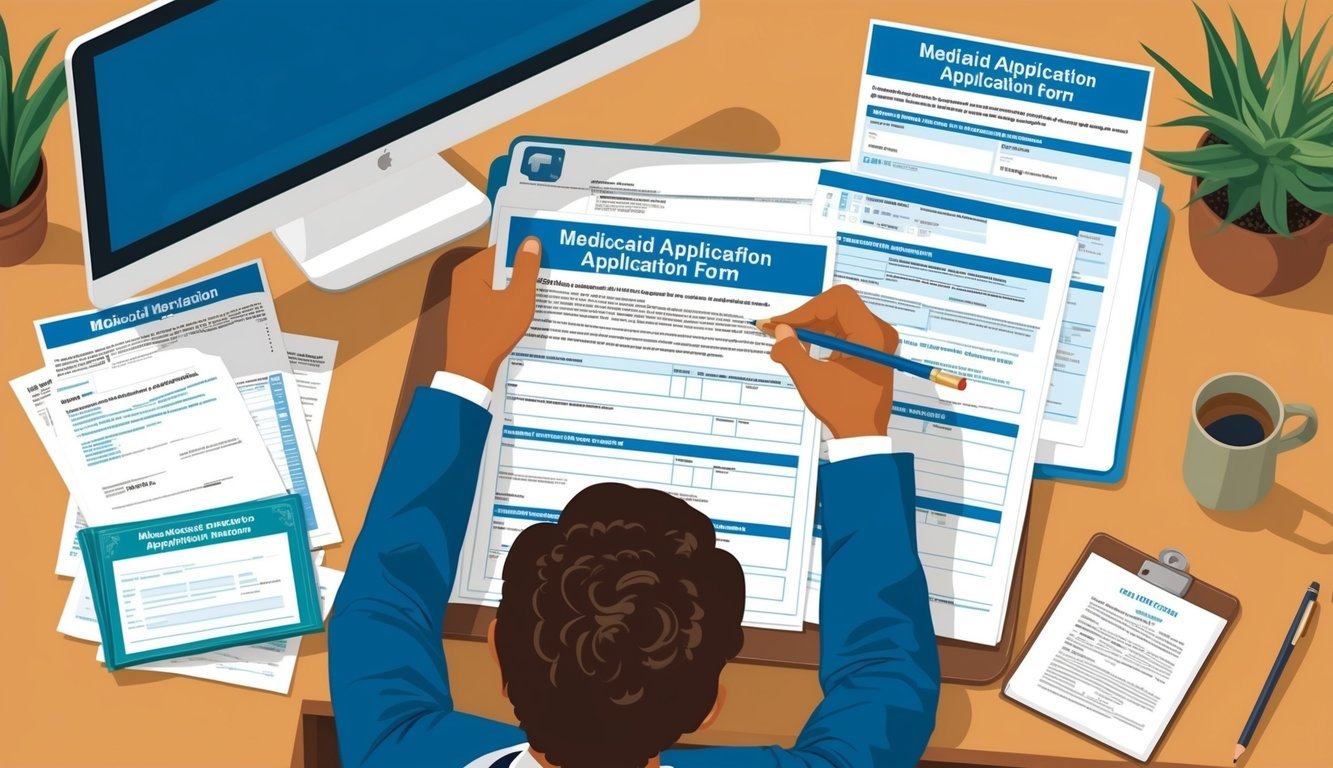Signing up for Medicaid in Ohio can seem tricky, but it’s easier than you might think.
You have a few ways to get started.
You can apply online, by phone, in person, or by mail.
The best option depends on what works for you.

You can apply for Ohio Medicaid online, by phone, in person, or by mail. Each method has its perks.
The online application is quick and can be done from home.
Phone and in-person options let you ask questions as you go.
Mail might be best if you prefer paper forms.
Before you apply, gather some key info.
You’ll need proof of income, your Social Security number, and info about your household.
This helps speed up the process.
Once you apply, the state will review your info and let you know if you qualify.
Key Takeaways
- You can apply for Ohio Medicaid in several ways, including online and by phone
- Gather important documents like proof of income before you start your application
- After applying, you’ll be notified about your eligibility and next steps
Eligibility and Enrollment
Signing up for Medicaid in Ohio involves meeting specific criteria and following a straightforward application process.
You’ll need to understand the eligibility requirements, know how to apply, and be aware of important deadlines and documentation needed.
You can apply online through the Ohio Benefits website, by phone, or in person at your local Department of Job and Family Services office.
It’s important to gather necessary documents, such as proof of income and residency, to ensure a smooth application process.
If you’re also looking for information on how to sign up for Medicare, you can visit the official Medicare website or contact a local agency for assistance.
Understanding Ohio Medicaid Eligibility
You might qualify for Ohio Medicaid if you’re in certain groups.
These include kids, pregnant women, older adults, people with disabilities, and some adults with low income.
Your income and family size matter a lot for eligibility.
Ohio expanded Medicaid under the Affordable Care Act.
This means more adults can get coverage.
You can now qualify if your income is up to 138% of the federal poverty level.
Each group has its own rules.
For example, kids can qualify with family incomes up to 206% of the poverty level.
Pregnant women have higher income limits too.
Your assets might also be looked at, especially for long-term care Medicaid.
But for most Medicaid programs, they don’t count your assets.
How to Apply for Medicaid in Ohio
You’ve got options when it comes to applying for Medicaid in Ohio.
You can do it online, by phone, in person, or by mail.
The easiest way is often online.
To apply online, go to Ohio Benefits website.
You can also use Healthcare.gov.
These sites let you fill out your application and submit it right away.
If you prefer talking to someone, call the Ohio Medicaid Consumer Hotline at 800-324-8680.
They can help you apply over the phone.
Want to apply in person? Visit your local County Department of Job and Family Services office.
They can help you fill out the application and answer your questions.
By mail, you can get an application form from your county office or print one online.
Fill it out and mail it back to your county office.
Assistance with the Application Process
Applying for Medicaid can seem tricky, but you don’t have to do it alone.
There are people who can help you for free.
You can get help from application assisters or navigators.
These folks are trained to guide you through the process.
They can explain confusing terms and help you gather the right documents.
Your local County Department of Job and Family Services is a great resource.
They can answer questions about eligibility and help you apply.
If you’re applying online, the Ohio Benefits website has a chat feature.
You can ask questions in real-time as you fill out your application.
For phone help, call the Ohio Medicaid Consumer Hotline.
They can answer questions about the application process and your eligibility.
Remember, getting help is your right.
Don’t hesitate to reach out if you’re confused or stuck.
Open Enrollment and Special Enrollment Periods
Unlike some health insurance programs, Medicaid doesn’t have a set open enrollment period.
You can apply for Medicaid any time of the year.
If you’re eligible, your coverage can start right away.
Sometimes it can even be backdated up to 3 months if you had medical expenses during that time.
While there’s no open enrollment, you do need to renew your Medicaid coverage every year.
The Ohio Department of Medicaid will let you know when it’s time to renew.
Special enrollment periods don’t apply to Medicaid.
These are for other types of health insurance.
But if you lose Medicaid eligibility, you might qualify for a special enrollment period to get other coverage.
Remember, your eligibility can change if your income or family situation changes.
Always report these changes to avoid any gaps in your coverage.
Income Guidelines and Documentation
Your income is a big factor in Medicaid eligibility.
Ohio uses the Modified Adjusted Gross Income (MAGI) to figure out if you qualify.
For most adults, your income needs to be at or below 138% of the federal poverty level.
This amount changes based on your family size.
For example, for a single person, it’s about $18,754 per year in 2024.
When you apply, you’ll need to prove your income.
This could include recent pay stubs, tax returns, or a letter from your employer.
If you’re self-employed, you might need to provide profit and loss statements.
Other documents you might need include:
- Proof of Ohio residency
- Proof of citizenship or immigration status
- Social Security numbers for everyone applying
- Information about other health insurance you might have
Keep in mind, some people, like pregnant women and kids, can qualify at higher income levels.
Always apply if you’re not sure – the worst they can say is no.
After Enrollment

Once you’re enrolled in Ohio Medicaid, you’ll need to take a few important steps.
These include picking a health plan, managing your account, and keeping your information up to date.
Choosing a Health Plan and Provider
After you sign up for Medicaid, you’ll need to pick a health plan.
You can do this through the Ohio Benefits Self-Service Portal.
You’ll have several options to choose from.
Take your time to compare the plans.
Look at what doctors and hospitals are in each network.
Think about any special health needs you have.
Once you pick a plan, you’ll need to choose a primary care provider.
This is the doctor you’ll see for most of your care.
You can usually find a list of providers on your health plan’s website.
Pick someone close to your home or work.
If you don’t choose, the plan might assign you one.
Remember, you can change your plan or provider if you’re not happy.
You don’t have to stay with your first choice forever.
Managing Your Medicaid Account
You’ll use the Ohio Benefits Self-Service Portal to manage your Medicaid account.
This is where you can see your coverage details and make changes.
You can log in anytime to check your benefits or update your info.
The portal lets you do things like:
- Print a temporary ID card
- See what services are covered
- Check the status of claims
- Find out about co-pays
If you have trouble using the portal, you can call Ohio Medicaid for help.
They have people who can walk you through it.
Keep your login info safe.
Don’t share it with anyone.
This helps protect your private health info.
Reporting Changes to Your Situation
Your life can change a lot in a year.
When it does, you need to tell Medicaid.
This is really important.
Changes in your income, family size, or address can affect your coverage.
You should report changes like:
- Getting a new job or losing a job
- Having a baby
- Getting married or divorced
- Moving to a new address
You can report these changes online through the Ohio Benefits portal.
You can also call or visit a local office.
Do this as soon as you can after the change happens.
If you don’t, you might lose your coverage or owe money back.
Long-Term Services and Supports
If you need ongoing care, Ohio Medicaid offers Long-Term Services and Supports.
These help people who have trouble with daily tasks like bathing or eating.
You might be able to get help at home or in a nursing facility.
To get these services, you’ll need an assessment.
A nurse or social worker will visit you to see what help you need.
They’ll work with you to make a care plan.
Some services you might get include:
- Help with bathing and dressing
- Meals delivered to your home
- Adult day care
- Transportation to doctor visits
These services can help you stay independent.
If you think you need them, talk to your Medicaid case worker.
They can start the process for you.
Frequently Asked Questions
Applying for Medicaid in Ohio can seem tricky, but it doesn’t have to be.
Here’s the scoop on some common questions to help you navigate the process smoothly.
What’s the process to apply for Medicaid in Ohio if you’re an adult?
You’ve got options when it comes to applying for Ohio Medicaid.
You can do it online, by phone, in person, or even by mail.
The easiest way is usually online through the Ohio Benefits Self Service Portal.
Pick the method that feels right for you.
Remember, the universe has a way of guiding us to the path that’s meant for us.
Can you check your Ohio Medicaid eligibility online, and how?
Yes, you can! The Ohio Benefits Self Service Portal is your friend here.
You can create an account and answer some questions about your situation.
It’s like looking into a crystal ball, but way more accurate.
The portal will give you a good idea if you might qualify.
What paperwork should you gather when applying for Medicaid in Ohio?
Get ready to do some digging.
You’ll need proof of income, like pay stubs or tax returns.
Don’t forget your ID and Social Security card.
Think of it as a spiritual cleanse for your filing cabinet.
Gathering these documents can be a meditative process, helping you reflect on your life journey.
What are the income limits to be eligible for Medicaid in Ohio this year?
Income limits change like the seasons.
They depend on your household size and the specific Medicaid program.
Generally, if your income is at or below 138% of the federal poverty level, you might qualify.
Remember, abundance comes in many forms.
Even if your income seems high, don’t let that stop you from checking your eligibility.
How do you get your hands on an Ohio Medicaid application form in PDF?
You can snag a PDF application form from the Ohio Department of Medicaid website.
If you’re old school and prefer paper, this is your ticket.
There’s something satisfying about filling out a form by hand.
It’s like leaving your mark on the physical world, a small act of creation.
Typically, how long’s the wait to get the green light on your Medicaid application in Ohio?
The wait can feel like an eternity, but it’s usually about 30 days.
Sometimes it’s quicker, sometimes it takes longer.
It depends on your situation and how busy they are.
Think of it as a lesson in patience.
The ancient Greeks believed that patience was a virtue bestowed by the gods.
Use this time to reflect and prepare for the next steps in your healthcare journey.

